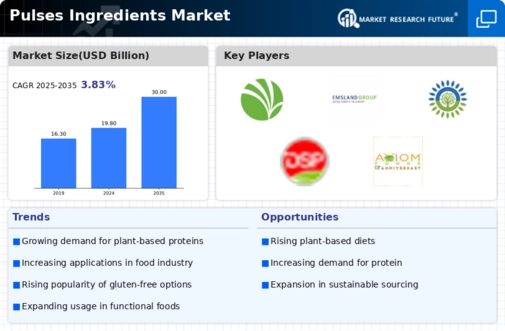Top Industry Leaders in the Pulses Ingredients Market

The competitive landscape of the pulses ingredients market is characterized by a mix of established players and emerging companies, each employing distinct strategies to navigate the industry. As of 2023, key players dominating the market include
- Ingredion Incorporated (US)
- Roquette Frères (France)
- Emsland Group (Germany)
- The Scoular Company (US)
- Archer Daniels Midland Company (US)
- SunOpta Inc. (Canada)
- Diefenbaker Spice & Pulses (Canada)
- Axiom Foods Inc. (US)
- Cosucra Groupe Warcoing SA (Belgium)
- Dakota Dry Bean (US)
Strategies Adopted:
One prevalent strategy adopted by key players is the diversification of product portfolios. Ingredion Incorporated, for instance, has expanded its range of pulse-based ingredients to cater to the growing demand for plant-based and protein-rich products. This strategic move aligns with the increasing consumer preference for healthier and sustainable food options. Similarly, Archer Daniels Midland Company has focused on developing value-added pulse ingredients, enhancing its offerings to meet the evolving needs of food manufacturers.
Strategies Adopted:
Global expansion has been a cornerstone strategy for several players in the pulses ingredients market. Roquette Frères, a major player in the industry, has strategically expanded its production facilities across different regions to ensure a robust and geographically diversified supply chain. This not only reduces operational risks but also positions the company as a reliable global supplier of pulse ingredients, fostering stronger relationships with clients worldwide.
Market Share Analysis Factors:
Factors influencing market share analysis in the pulses ingredients sector include the quality and functionality of products, pricing strategies, and geographical reach. High-quality ingredients with proven functionality, such as improved texture or nutritional value, often command a larger market share. Pricing strategies that balance competitiveness with maintaining profit margins are crucial for sustained market presence. Moreover, a broad geographical reach through efficient distribution channels is imperative to tap into diverse markets and demographics.
In the dynamic landscape of the pulses ingredients market, new and emerging companies are making noteworthy strides by introducing innovative products and production techniques. Start-ups like NutraPulse Technologies and Green Harvest Ingredients are gaining attention by focusing on specialty pulse ingredients, such as pulse flours with enhanced nutritional profiles. These companies leverage their agility to adapt swiftly to market trends and capitalize on the increasing consumer demand for plant-based and clean-label products.
Industry Trends:
Industry news and current investment trends indicate a shift towards sustainability and technological advancements. Pulses are recognized for their environmental benefits, including nitrogen fixation, and companies are increasingly emphasizing sustainable sourcing and production practices. Investment trends reveal a growing commitment to research and development, with companies investing in innovative processing technologies to enhance the functionality and versatility of pulse ingredients.
Competitive Scenario:
The overall competitive scenario in the pulses ingredients market is marked by intense competition and a constant pursuit of differentiation. Established players are investing in research and development to uncover new applications and functionalities of pulse ingredients. The emphasis on clean-label products, coupled with the rising trend of plant-based diets, is reshaping the competitive landscape as companies strive to align with evolving consumer preferences.
Recent Development
The pulses ingredients market has seen a surge in mergers and acquisitions. Established players are acquiring smaller companies to broaden their product portfolios and gain a competitive edge. This trend is driven by the desire to offer comprehensive solutions to food manufacturers seeking diverse pulse ingredients for their formulations. Additionally, companies are actively monitoring regulatory changes and global supply chain disruptions, adapting their strategies to navigate challenges effectively.


